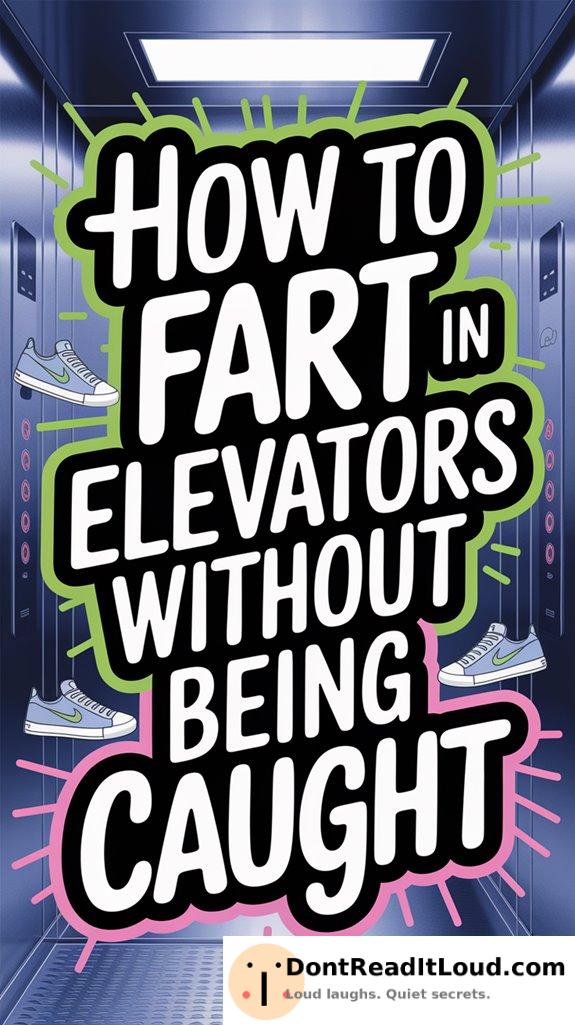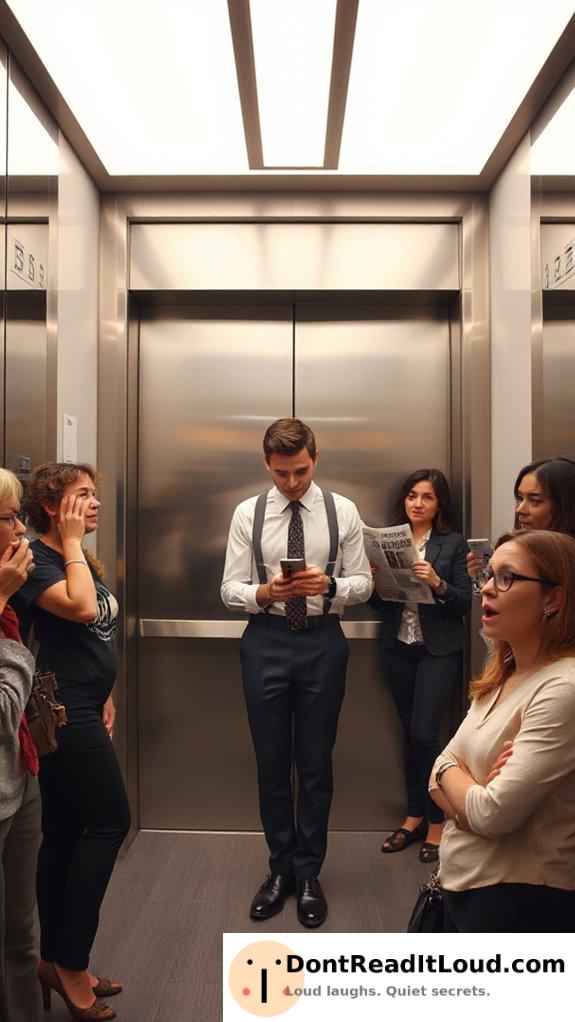
To fart in elevators without being caught, stand near the door or in a corner, and wait for distractions like door openings or elevator dings. Relax and shift your weight to quietly release gas, and time it with noises like coughs to cover any sound. Avoid eating strong-smelling foods beforehand to help keep things discreet. If you stay calm and act normally, people are less likely to notice. Stay tuned for even smarter ways to blend in.
Understanding Elevator Dynamics

Although elevators seem simple, their environment influences how odors linger and travel.
When you enter, you’re stepping into a small, enclosed area with minimal ventilation. How crowded the elevator is matters—a full car gives smells more people to mingle with, but less space for them to escape.
In contrast, a nearly empty elevator leaves fewer places for scents to disperse, making them more noticeable. Limited airflow allows any odor, even a subtle one, to stick around longer than expected.
Pay attention to how air shifts, especially when the doors open and close. Knowing these factors helps you understand your impact on fellow passengers and lets you avoid drawing unwanted attention.
Timing Your Move

A well-timed release can mean the difference between going unnoticed and becoming the subject of everyone’s suspicion. Mastering timing is crucial if you want to avoid blame in an elevator.
Don’t act on impulse; instead, look for moments that reduce your chances of being noticed. For example, wait until the doors open or close, as people entering or leaving create natural distractions. If someone coughs, sneezes, or talks loudly, use that noise as cover.
Brief pauses between floors are less ideal, since people’s attention stays focused. Quick, subtle moves work best when everyone is distracted. With careful timing, you’ll blend in and make your release nearly undetectable.
Be patient and take advantage of the right opportunity.
Positioning Yourself Strategically

Where you stand in an elevator can greatly affect whether your plan goes unnoticed. Avoid the center, since sound and scent spread easily from there. Instead, choose a corner near the doors for a quick exit when your floor arrives.
Good manners mean not trapping others or drawing attention to yourself. Stay along the edges, but give people space—crowding is poor etiquette. If you can, stand by someone who’ll leave soon so the scent goes with them.
Picking your spot carefully helps you avoid suspicion and stay discreet.
Mastering the Silent Release

Once you’ve found the right spot, the next step is making sure your release goes unnoticed. Mastering silent techniques is essential.
Tight clothing can make things challenging, so shift your weight to one leg and relax your glutes slowly. Letting out gas gradually helps prevent any surprise noises. Try to time your release with elevator sounds—like doors closing, fans running, or footsteps—to cover any minor noise.
Silent techniques are only part of the solution, though. Odor control matters, too. Avoid foods known for strong smells before elevator rides. If you’re concerned about odor, carry a discreet air freshener or wear extra layers to help trap any scent.
Stay calm and in control.
Distraction Techniques That Work

Nobody wants to stand out in a cramped elevator, so subtle distraction is essential. If you sense attention shifting, redirect it with a timely cough or by glancing at your phone.
You can also mask sounds by dropping your keys, shuffling your feet, or clearing your throat as you act discreetly. Take advantage of elevator dings or ringing phones to cover up any noise.
Start a brief conversation or comment on the weather or city view to shift focus. With these tactics, your actions will blend in, keeping your secret safe.
Handling the Aftermath With Poise

Even if your attempts at subtlety don’t work, you can still handle things with assurance. Stay composed—showing anxiety only attracts more notice.
If someone reacts to the smell, avoid shifting your eyes or appearing uneasy. Keep your posture relaxed and try making casual conversation to shift attention elsewhere.
Good aftercare matters: use odor-neutralizing sprays or scented sanitizer discreetly if you have them. A light spritz on your hands or clothes can help cover up any lingering scent.
If others start leaving the elevator, you might want to exit too, which can reduce suspicion. Most importantly, don’t apologize or admit anything; staying calm and collected protects your dignity.
Confidence is your best approach.
Conclusion
Now you know how to discreetly let one go in an elevator. If you master timing, positioning, and silent release, your secret stays safe. Distraction techniques give you an extra escape route, and acting confidently afterward helps you blend in. Next time you’re in a tight spot, remember these tips to get through any elevator ride unnoticed. Just use your new skills wisely—and don’t forget to keep it lighthearted!



